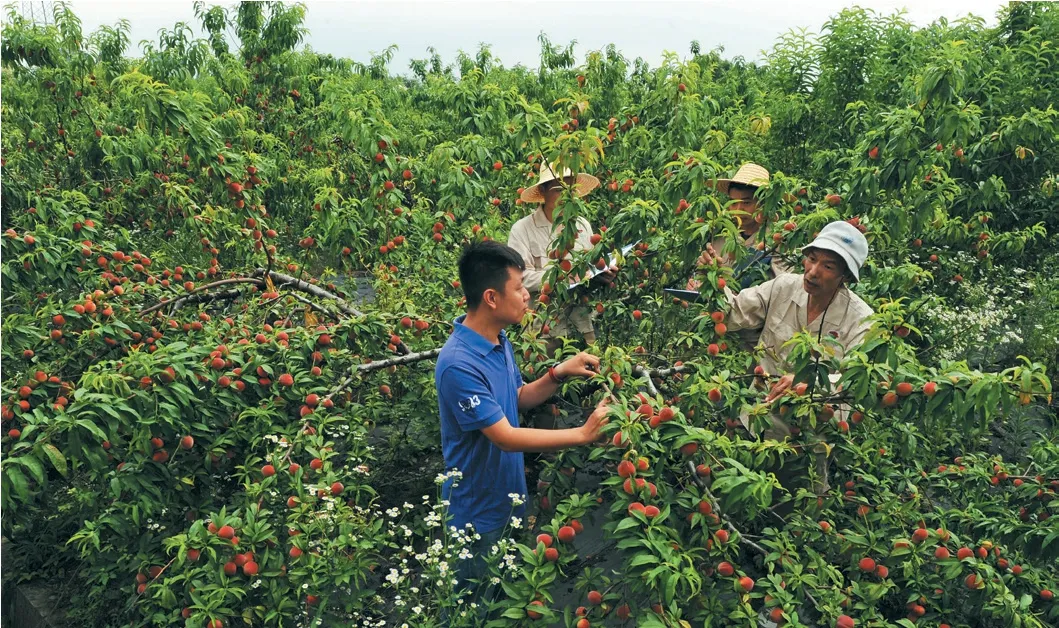THIS WEEK
2020-06-24

MECHANIZED HARVEST
Agricultural machinery is used to harvest wheat in Xinyi Township in Handan City, Hebei Province, north China, on June 5.
Large-scale reaping in Hebei started from Handan in the southern part of the province on June 5 and is expected to be finished in its northern city Tangshan around June 21.
Sweet Result

A farmer picks grapes in Tangshan, a city in Hebei Province in north China, on June 9.
Air Traffic Up
The air passenger number hit 1.03 million on June 5, rebounding to 61.5 percent of the level seen in the same period last year, according to the Civil Aviation Administration of China.
The number of flights had jumped to 11,333 on the same day, reaching a new high since February.
The recovery pace of air traffic has accelerated significantly since May. From June 1 to 5, average daily passenger numbers rose to 935,200, recovering to 57.4 percent of the level of the same period last year.
Flood Damage
Rain-triggered floods in south China had affected some 2.63 million people in 11 provincial-level regions as of 2 p.m. on June 9, the Ministry of Emergency Management said.
Heavy rains forced the relocation of about 228,000 people, destroyed more than 1,300 houses and inflicted direct economic losses of over 4 billion yuan ($566 million).
Since June 2, downpours have hit large parts of south China, bringing accumulated precipitation of 100-300 mm in some regions.
Affected by the rainstorms, 110 rivers in eight provincial-level regions have risen above the red line.
Risk Survey
China will conduct its first national survey on natural disaster risks to better prepare for potential disasters, an official circular said on June 8.
The survey, to be carried out from 2020 to 2022, is aimed at figuring out hidden hazards across the country and getting a clear picture of key regions’ ability to respond to natural disasters so that governments at all levels can make informed disaster-control decisions, according to the State Council circular.
It will include investigation and assessment of factors that lead to major natural disasters such as earthquakes and floods, as well as assessment of the country’s disasterrelief capabilities.
Pesticide Test
Chinese researchers have developed a rapid detection system that can track multiple pesticide residues in about 5 minutes, according to the Chinese Academy of Agricultural Sciences (CAAS) on June 8.
CAAS professor and research team leader Wang Jing said the rapid detection system integrates immunodetection, image identification, artificial intelligence, big data and the Internet of Things.
By uploading a photo of the test strip to the WeChat mini program, testers can obtain results on their mobile phones within minutes of system data analysis.
The system is suitable for government authorities and agricultural producers to make quick detections.
Longer Lives
The average life expectancy of Chinese citizens rose from 77 years in 2018 to 77.3 years in 2019, according to statistics released by the National Health Commission on June 6.
China saw a falling maternal mortality rate, from 18.3 per 100,000 in 2018 to 17.8 per 100,000 in 2019, the commission said in an annual communiqué on health development.
Infant mortality rate decreased from 6.1 per 1,000 in 2018 to 5.6 per 1,000 in 2019.
More medical care services are available across the country. By the end of 2019, the number of healthcare institutions nationwide reached 1.01 million, providing over 8.8 million beds for patients.
Compared with the previous year, there were 1,345 more hospitals and 10,751 more community-level healthcare institutions in 2019.
Xinjiang 5G
Xinjiang Uygur Autonomous Region in northwest China plans to invest over 2 billion yuan ($282 million) to build nearly 4,900 5G base stations this year.
The regional communications administration said on June 8 that builders of local commercial and industrial parks are installing 5G equipment on existing 4G communication towers across the region. The method can save construction time, reduce costs and maximize the use of resources.
So far, the region has installed 3,364 5G base stations.
By the end of this year, urban areas of Urumqi, capital of Xinjiang, are expected to get full 5G coverage, while other prefectures and cities will have 5G network.
Tibet Projects
Twenty-six construction projects covering infrastructure, public services and tourism were officially launched in Nyingchi, Tibet Autonomous Region in southwest China, on June 10.
A ground-breaking ceremony for the projects, with a total investment of 302 million yuan ($42.7 million), was held in the village
of Caimen. Part of a pairing-up assistance program between Guangdong Province in south China and Tibet, the projects are estimated to provide jobs for more than 650 locals.
The one for the Caimen scenic spot, for instance, aims to develop the area into a tourist zone along the Yarlung Zangbo River and will increase the income of farmers and herders, Executive Vice Mayor of Nyingchi Liu Guangming said.
Migmar, Director of the Caimen villagers’ committee, said villagers will be encouraged by the project to provide homestay services and open restaurants.
The More the Merrier

Thirty couples have a group wedding in Boao, a township in Hainan Province in south China, on June 6. Some of them had participated in epidemic control work in Hubei Province in central China and had to postpone their wedding.
Legoland Park
Construction of a Legoland park started in the city of Meishan in Sichuan Province, southwest China, on June 8.
The 24.3-hectare park, the first Legoland in China, will have an estimated investment of 3 billion yuan ($424 million). It is expected to start operation in 2023, according to the Meishan Municipal Government.
It anticipates more than 10 million visitors each year and generating over 10,000 employment opportunities.
Britain-based Merlin Entertainments partnered with a Chinese joint venture in September 2019 to develop and run the park.Legoland currently operates in eight countries, including the U.S., UK, Denmark, Germany and Japan.
Returning to School

Peking University students return to school on June 6. Students of over 20 universities in Beijing who are graduating this year have returned to school.
FTP Benefits
Market entities will enjoy a number of benefits in investment, tax and market access when doing business in the Hainan Free Trade Port (FTP), Shen Xiaoming, Governor of Hainan Province, south China, said on June 8.
License application and government approval will not be required for industries that are not prohibited by law or mandatory standards, Shen told a press conference in Beijing.
Foreign investment will be subject to a management system combining pre-establishment
national treatment and a negative list designated for the FTP, further reducing restrictions and prohibitions on the basis of free trade zones, Shen said.
Domestic firms registered in the FTP will be encouraged to raise funds by issuing shares abroad. The FTP will also offer tax benefits for firms operating in sectors such as tourism, modern services and new and high technology by exempting enterprise income tax for the income from their direct investment overseas.
The southern island province will further open the tertiary industry by reducing restrictions on market access. Efforts will be made to deepen opening up in sectors such as shipping, telecommunication, business services, education, culture and sports, according to Shen.
Foreign securities, futures and fund management institutions are encouraged to establish wholly owned or joint-venture financial institutions, while overseas universities or vocational colleges specializing in engineering, technology, agriculture and medicine can independently run schools in Hainan, he said.
Government Bonds
The Ministry of Finance on June 8 called for efforts to expedite the issuance of local government bonds and accelerate the use of the funds raised from those bonds.
Funds raised from special local government bonds should primarily be used to invest in major sectors and projects, according to a statement issued by the ministry after a national meeting of financial officials.
The funds should also be used to catalyze investment from the private sector to support sectors that address inadequacies, improve people’s wellbeing, and boost consumption and domestic demand, it said.
Preventing debt risks should be prioritized, Finance Minister Liu Kun said at the meeting, urging efforts to enhance regulation in order to hold accountable those responsible for illegal and irregular practices in bond issuance. He also ordered risk control to forestall systemic risks.
China plans to issue 3.75 trillion yuan ($528.91 billion) of special local government bonds this year, 1.6 trillion yuan ($226 billion) more than last year.
Officials at the meeting agreed to increase government investment to counter the downward pressure on economic growth, expand tax and fee reduction policies to help enterprises tide over hard times, and strengthen budget balance to mitigate the adverse impact of the epidemic on fiscal revenue growth.
China has vowed to pursue a more proactive and impactful fiscal policy, setting its fiscal deficit above 3.6 percent of GDP, 0.8 percentage point higher than that of 2019.
New Home, New Job

A worker makes lighters at the workshop of an enterprise in Dalong Economic and Technological Development Zone in Tongren, Guizhou Province in southwest China, on June 6. In recent years, the development zone has supported relocated people to get employed. As of June 1, a total of 39 enterprises above designated size in the zone had provided 10,755 jobs for resettled residents from inhospitable areas.
Financial Support
The China Banking and Insurance Regulatory Commission (CBIRC) said financial support will be stepped up for new infrastructure, fresh urbanization initiatives and major projects as part of efforts to boost the economy amid the novel coronavirus control.
The CBIRC will continue epidemic control measures while focusing on supporting companies and ensuring employment, the commission said in a statement made public on June 8.
It will act proactively to help manufacturing, aviation, cultural and tourism industries ease debt pressure, it said.
The CBIRC will also continue strict regulation of the shadow banking sector and crack down on financial irregularities as part of the efforts to forestall financial risks.
It will deepen reform and opening up of the banking and insurance industries and support the development of direct financing.
The country will step up the construction of new types of infrastructure, strengthen the development of a new kind of urbanization, and redouble efforts to develop major transportation and water conservancy projects, according to this year’s government work report.
Green Development
Minister of Agriculture and Rural Affairs Han Changfu on June 5 stressed the role of green agricultural development in stepping up high-quality growth in the sector and its rural vitalization.
The country should enhance agricultural modernization that ensures output efficiency and product safety, conserves resources and is environmentally friendly, Han said at a conference on green agricultural development.
Han stressed the crucial role of green development in relieving the pressure on resources, controlling pollution in agriculture and rural areas and promoting sustainable agricultural development.
Measures would be taken to achieve green development in agriculture, such as protecting land and water resources while increasing the effectiveness of fertilizer and pesticide, as well as enhancing ecological farming, he said.
More work would be done to adjust and optimize agricultural structure and regional layout, facilitate standardized production and strengthen supervision over the safety of agricultural products.
More Consumption
Efforts will be made to further stimulate consumption, dovetailing it with the development of the transport sector, according to the Ministry of Transport (MOT).
The ministry will ramp up the construction of infrastructure, rapidly develop urban public transportation, and build logistics facilities in rural areas to tap consumption potential, said a circular released by the ministry.
The document called for improving the quality of passenger transport, transfer services and ticketing for better travel experience.Logistics service will be strengthened to meet rising consumption demands, with more advanced technology in place to promote cold chain logistics.
The transport sector will work with other industries such as tourism and information sectors to facilitate travel and accelerate digitization of transport infrastructure, according to the document.
The MOT also stressed the use of new energy vehicles to promote green transportation.
Fruitful Effort

An agricultural expert (right) explains a technique for improving yield of peaches to farmers at a cooperative in Jiaxing, Zhejiang Province in east China, on June 5. By developing vegetable and fruit cooperatives with the help of seed companies, local farmers in Jiaxing have achieved rising yields and income.
Poverty Relief
More impoverished migrant workers had found employment by the end of May compared with last year’s total, as the country continues efforts to win the battle against poverty by 2020, official data showed.
As of May 31, some 27.51 million poor migrant workers from 25 provincial-level regions had left their hometowns for work, accounting for 100.79 percent of the total last year, according to the State Council Leading Group Office of Poverty Alleviation and Development.In 52 key poverty-stricken counties, the number of poor laborers that went outside for work this year stood at 2.73 million, which is also higher
than the annual figures from 2019.Meanwhile, 373,600 poverty
alleviation projects in 22 provinciallevel regions of central and western China had restored production as of May 31, with most leading poverty-alleviation enterprises and workshops in these regions back on track, offering employment for more than 1.18 million poor people.
These areas have also seen improvements in consumption-led poverty-relief projects, which have covered 52,190 types of products from 1,532 counties and 19,223 suppliers. These projects aim to engage urban residents in buying products from impoverished areas to increase local people’s income.
Aiming to eliminate poverty, the country is making headway in establishing a mechanism to prevent people from falling back into poverty and provide targeted assistance.
Embracing a New Sales Mode

Online hosts promote garments via a live-streaming platform in Xinji, Hebei Province in north China, on June 5. Training sessions on live-streaming sales have been held by the local government for enterprises to promote sales of their products since this year.

GREECEGreek Foreign Minister Nikos Dendias (right) and his Italian counterpart Luigi Di Maio sign an agreement on the delimitation of maritime zones between the two countries in Athens on June 9

FRANCEWorkers remove the scaffolding at the Notre Dame Cathedral in Paris on June 9. It was erected to repair the monument left badly damaged by a fire last year

UNITED KINGDOMPrime Minister Boris Johnson speaks at the virtual Global Vaccine Summit from 10 Downing Street, London, on June 4. World leaders pledged $8.8 billion to provide equal access to vaccines for all

GERMANYEuropean Central Bank (ECB) President Christine Lagarde speaks during a press conference live-streamed from the ECB headquarters in Frankfurt on June 4. The ECB said its pandemic emergency purchase program would expand to 1.35 trillion euros ($1.51 trillion)

YEMENA boy displays the locusts he captured after a swarm invaded Dhamar Province on June 6

SOUTH AFRICADemonstrators take part in an anti-racism protest sparked by the U.S. police killing of George Floyd, an unarmed African American, in Johannesburg on June 8
↓ INJURED EYE DOCTOR RETURNS TO WORK
Tao Yong, Director of the ophthalmology department of Beijing Chaoyang Hospital who suffered hand and head injuries in January, made a live-streaming of eye-care knowledge on June 6, National Eye Caring Day.
On January 20, he was attacked by a knife-wielding former patient, who broke his left hand and caused severe skull trauma. The attacker was arrested and a police investigation is ongoing.
The 40-year-old Tao, who’s been back to work since a month ago, is treating outpatients once again. He started work in the hospital in 2007 and has performed more than 15,000 eye operations.
However, he may never be able to perform precision eye surgery again. The intrepid eye doctor is now planning for academic research and popularization of medical knowledge apart from his regular outpatient service. And despite his traumatic experience, he is encouraging youngsters to pursue a career in medicine to heal the wounded and help the sick.

Left-Behind Children’s Care
Guangming Daily
June 8
The Ministry of Civil Affairs has launched a yearlong program to train “directors” in charge of left-behind children in villages and townships and disseminate information on state policies for the children to improve their care.
Ten years ago, a demonstration project on Chinese children’s welfare was jointly initiated by the ministry, United Nations International Children’s Emergency Fund and Beijing Normal University, covering 120 villages. The system of children’s directors was developed at that time.
The directors are generally teachers in kindergartens and primary schools. They are asked to take responsibility for the children and their education by regularly visiting them at their home and collecting information about their welfare and their families. Today, there are 663,000 children’s directors in villages and townships.
According to the ministry, by the end of August 2018, there were 6.97 million left-behind children in rural areas whose parents were migrant workers engaged in cities. This program was designed to guide such children, especially those in difficult situations, to improve their awareness and their protection.
Besides welfare policies and laws, the directors need to have a knowledge of family education so that they can guide parents and other guardians in rural areas to support children’s development.
Language Bridges
People’s Daily
June 4
During the novel coronavirus disease (COVID-19) prevention and control, the language service industry in China has contributed to communication on public health and promoted the country’s experience in combating the virus in the international community.
Seeking to exchange information, knowledge and culture, language services have grown into a modern service industry with cross-language ability. Due to the global pandemic, medical treatment cooperation between countries and regions has increased, from medical supplies exports to sharing experience in containment, where language services have become indispensable.
For instance, at the early stage of the epidemic, the Beijing Advanced Innovation Center for Language Resources at the Beijing Language and Culture University developed A Guide to the Prevention and Control of COVID-19 Epidemic in Foreign Languages based on a guideline by the National Health Commission. It was translated into more than 40 languages to help foreigners know about disease prevention and treatment on Internet platforms.
The growth of language service teams in the medical field reflects the results achieved in the cultivation of foreign language talents.
“We have seen some solidarity, but very little unity, in our response to the novel coronavirus disease... As a result, the virus has spread across the world and is now moving into the global South, where its impact may be even more devastating, and we are risking further spikes and waves.”
UN Secretary General António Guterres, saying the pandemic must be a wake-up call for greater multilateral economic cooperation and healthcare solidarity, in a video message on June 10
“To establish and improve at the state level the legal system and enforcement mechanisms for Hong Kong Special Administrative Region to safeguard national security is a prudent decision made by the central authorities in light of the developments in Hong Kong.”
Song Zhe, deputy head of the Hong Kong and Macao Affairs Office of the State Council, in an interview with Xinhua News Agency on June 11

A Chinese anti-epidemic medical expert team leaves for Palestine to help in the fight against the novel coronavirus disease from the Jiangbei International Airport in Chongqing, southwest China, on June 10
Today, each country attaches great importance to investment in branded drugs and medical supplies production. That requires the medical industry to update by expanding its medical corpus, raising standards in medical product trade and enhancing general translators’ knowledge of medical terms.
For the language service industry, it is necessary to introduce more intelligent technology to hone translators’ and interpreters’ competitiveness. Besides language services, the industry can provide other services such as consultation. Universities and colleges should expand the talent pool by strengthening language professionals’ intercultural communication ability and professional competence.
Targeted Training
China Economic Net
June 5
Over 7 million migrant workers will receive vocational training in 2020 and 2021 each as part of the efforts to stabilize employment and alleviate poverty, according to the Ministry of Human Resources and Social Security.
By 2019, there were over 290 million migrant workers in China, becoming the leading force in the labor market. But this large group still faces employment pressure in terms of stability and security, which has been worsened by the outbreak of the novel coronavirus disease.
To provide suitable training programs for them, local governments and institutions should focus on the kinds of skills they would like to learn. At the same time, the demands of the job market should be kept in mind. Construction, machinery, catering and logistics are among the industries where migrant workers can fit in well. The training should also offer courses related to new types of occupations such as online purchase delivery and live-streaming sales.
Today, many advanced technologies like big data are being used in vocational training for the group. Based on the experience during the epidemic, the Internet Plus mode can also be used in the programs to make them more convenient and efficient.
The ministry said enterprises should play a significant role in training migrant workers, both those who are working or have been furloughed, to help them get jobs. Rural areas that export laborers should lead the training for those returning to their hometowns, and help them find jobs or start businesses locally.
↓ DISABLED TEEN BECOMES ONLINE STAR

Zhang Jiacheng, a 13-year-old who lost his right arm in an accident at 5, recently gained wide attention online when a video of his basketball dribbling skills went viral.
In the video, Zhang displays his dribbling abilities in front of a defense line of several professional basketball players, and is cheered lustily by the watching spectators.
The setback in life has not made him forsake basketball, which he loves, or the willingness to improve his skills on court. He practices in all weather and has improved his skills remarkably.
Zhang has the best left hand, making him the real star in this game, former China Basketball Association player Wang Jing said after watching his performance.
Zhang has posted 13 videos of him honing his basketball skills on Douyin, the Chinese version of TikTok, which have been liked by almost 1 million viewers.
“It cannot be said that China’s opposition to violence is a suppression of freedom while the U.S. use of the police and military in protests is a defense of law and order. It is a confused judgment.”
Zheng Yongnian, a professor at the East Asia Institute of the National University of Singapore, in an interview with Xiakedao, a social media account run by the overseas edition ofPeople’s Daily, on June 6
“Hainan’s upgrade from a free trade zone to a free trade port, together with the existing 18 free trade zones, is shaping a more sophisticated opening-up architecture stretching from coastal to inland regions.”
Wang Huiyao, President of the Center for China and Globalization, a Chinese think tank, in an article inChina Dailyon June 11
